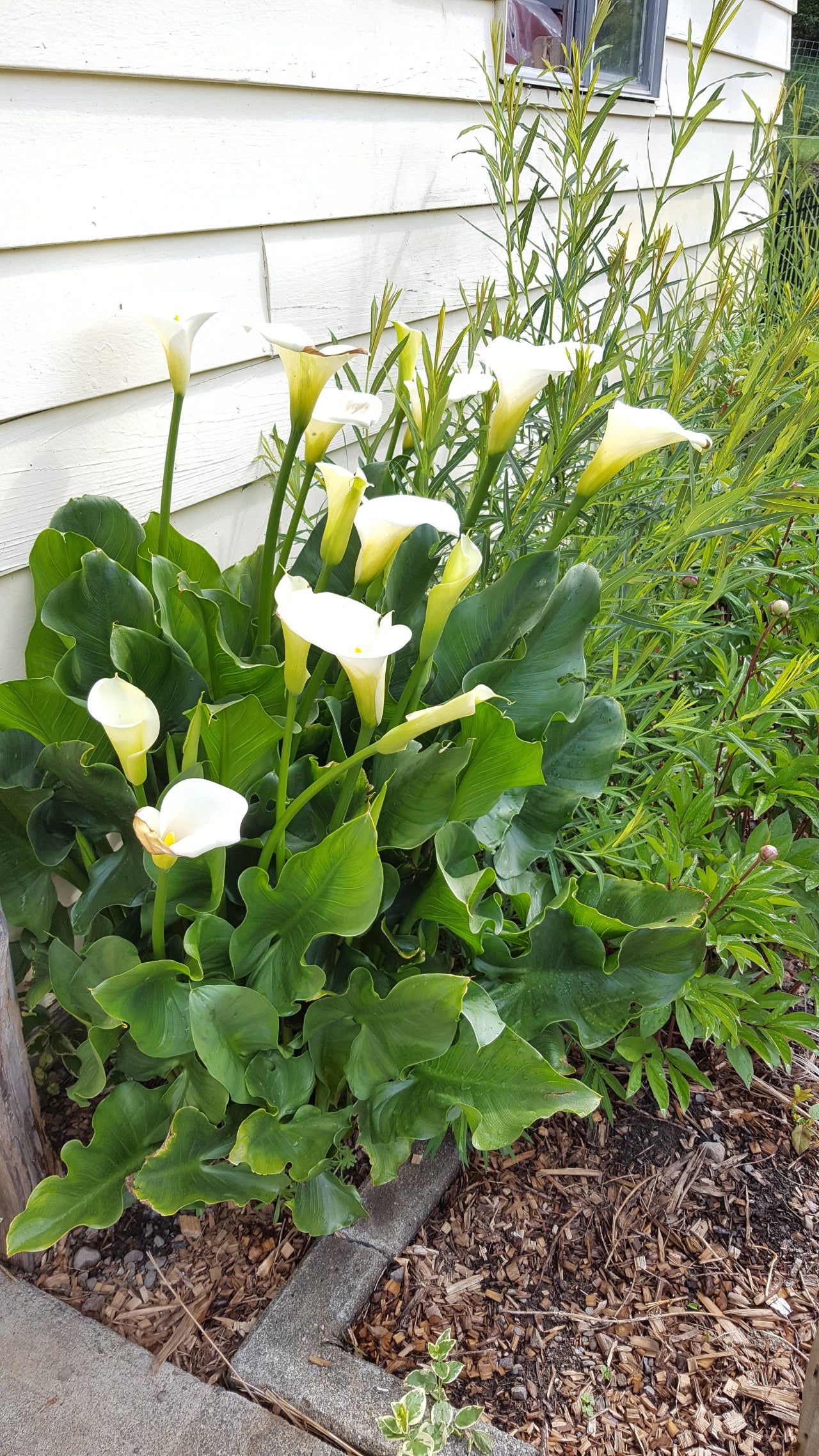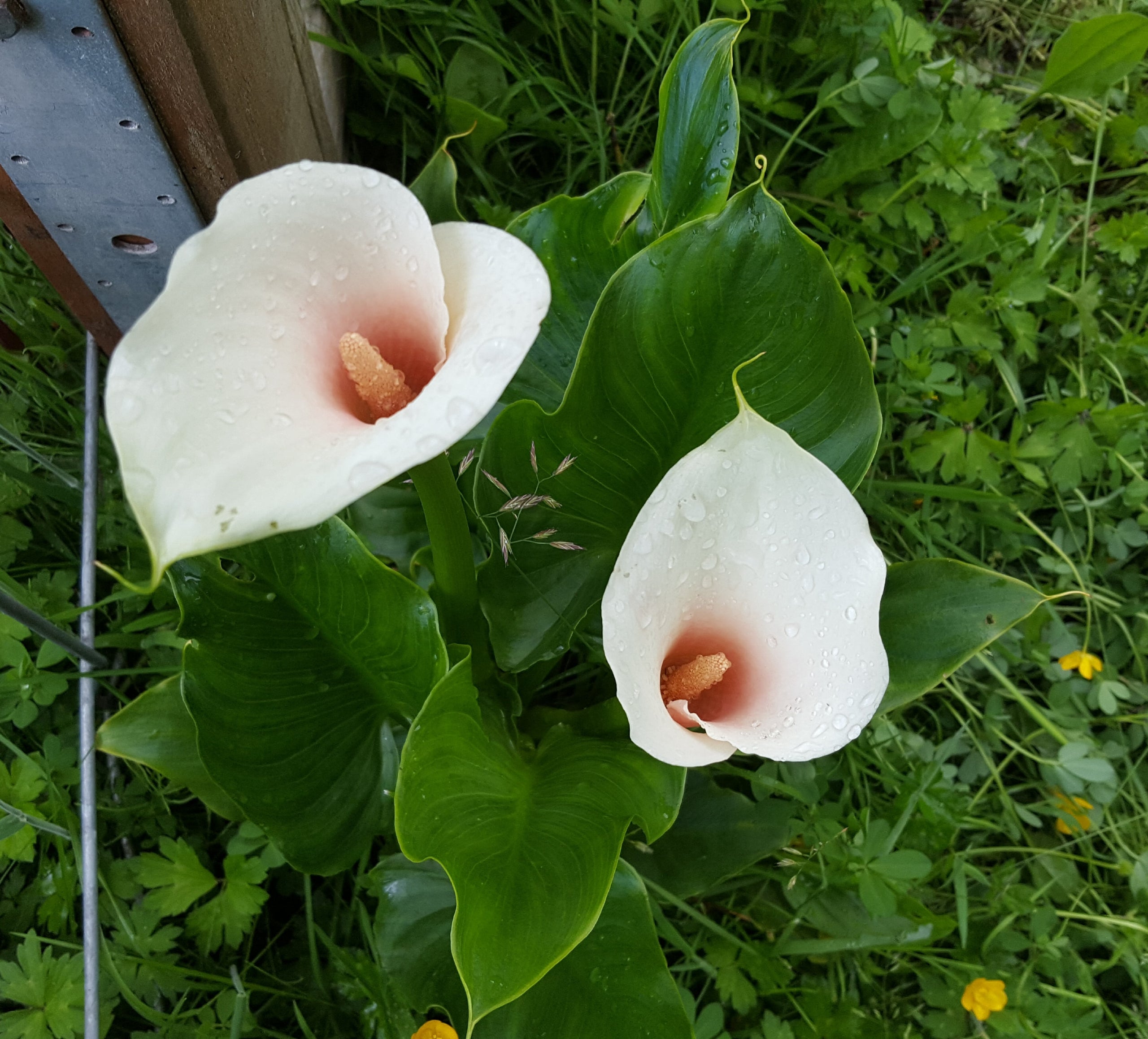Morphological Variation and Breeding Potential for Zantedeschia aethiopica
In recent times much breeding work has been done to develop a diverse hybrid swarm of calla lilies for the ornamental trade. However, these hybrids have been developed from species with less cold tolerance and environmental adaptivity than the classic white calla lily, Zantedeschia aethiopica.
It appears that the primary reason Z. aethiopica has been left out of the breeding work is that it produces albino embryos which can not survive outside a lab when crossed with other species. Never the less, hybridization may not be needed to see a new era of plant breeding with Z. aethiopica. This is because there is already a fair amount of genetic diversity within this species and if cultivars with unique traits are brought together and selected to concentrate and/or re-arrange genetics of various selections we could begin to see an increase in unique selections.
For many years there have been a small number of clones circulating that bore a faint pink tinge to the spathes, a welcome variation to the standard white. However, once a breeder in the Netherlands actually started intentionally growing out seedlings to select for more concentrated pink color an improved selection named 'Flamingo' was able to be produced, presumably through concentration of the genes which produce the pink color or possibly through chance mutation. The origin of this new selection was an open pollinated seed from the selection called 'Pink Mist'.
In Mexico some work is being done as well with a groundbreaking new selection being developed called 'Deja Vu'. This new form produces tri-colored spathes with a pink tinge at the base, fading to white and then tipped with green! It was the result of crossing between pale pink tinged forms and the green tipped spathe selection 'Green Goddess'.
Additional morphological variations exist which can be worked with as well. Current cultivars range from dwarf to giant and intercrossing could produce varying size forms of selections with unique spathe coloration. While the standard form of the species has solid green leaves, it is also possible for this species to present maculation or white spots on the leaves as is the case with the cultivar known as 'White Giant'.
That's not the end of the variations though. There is a rare (I hope to make it less rare) selection called 'African Gold' which displays striking golden stripes on the young foliage. While the stripes do fade as the leaves age, the nature of Z. aethiopica is to grow continuously until forced to go dormant via freeze or drought which means that as long as they are kept in active growth the ornate leaves will be produced. It is unclear at this point if the leaf stripes are caused by virus or genetic mutation, but either way this is another trait that could be combined with other selections for novel new types. Could you imagine the result if one were to combine a striped leaf type with a green tipped spathe type? It would almost certainly result in the production of white spathes with striped green and gold tips! Wouldn't that be exciting?
There is one final variant that is documented online with a single picture. That is a selection from the late plant explorer Rod Saunders in South Africa (the homeland of Z. aethiopica) called 'Rod's Red' which produces a white spathe with a splash of red on the outside. That's right, not just a pink blush, but an actual splash of red. I have been able to confirm by email that this selection was grown for a while by the micropropagation company Frontier Laboratory in Brackenfell, Cape Town, South Africa. Unfortunately, the spathe would necrose relatively quickly so it ended up not being put into production for sales and distribution. Despite this disappointing feature, it's fascinating that the genetic potential exists within this species for red and perhaps with a bit of breeding work an improved selection with longer lasting spathes could be developed. If you know anything more about this selection I'd love to hear from you.
List of reasons why it is worth focusing on breeding work with Z. aethiopica:
- Unlike the more common hybrids, it has no obligate dormancy period.
- Spathes are typically produced on longer, thicker stems than hybrid types making them superior for use in floral arrangements.
- Great adaptability to a range of soil types, succeeding in everything from well drained to boggy.
- Widely tolerant of a very wide range of sun exposures from full sun to full shade (though admittedly floppy in shade it still blooms reasonably well).
- Greater tolerance for cold.
So far I've been able to collect six different selections of Z. aethiopica, each being worth growing for their own sakes, but also allowing me access to enough genetic diversity to begin my own small scale breeding program. If I'm successful with developing any worthwhile new selection(s) I will offer them through my nursery with no patent protection so that anyone who acquires them may reproduce them without legal restrictions.
Selections currently in my collection:
*Standard species type: mid-size growth habit, white spathes, green leaves
*'White Giant': large growth habit, white spathes, maculated leaves
*'Green Goddess': mid-size growth habit, green tipped white spathes, green leaves
*'Ruby Blush': mid-size growth habit, pink blushed white spathes, green leaves
*'Deep Throat': mid-size growth habit, pink blushed white spathes, green leaves
*'African Gold': mid-size growth habit, white spathes, gold striped leaves
If you have good leads on additional selections with interesting traits that differ from what's already in my collection please let me know. Obviously missing from my collection is any dwarf type, but I should be able to acquire that within the year.


This comment has been removed by the author.
ReplyDeleteHallo Johann. I have a beautiful giant white Calla lily. I want to landscape the giant Calla lily with smaller Calla species in the garden, but I am worried I will lose the giant species to outbreeding. Will they cross breed naturally to a point that I don’t have the giant Calla anymore?
ReplyDeleteEven if the different strains cross, this will only affect any resulting seedings (should they even occur). It will not affect the original parent plants which regrow each year from perennial rhizomes.
Delete